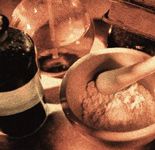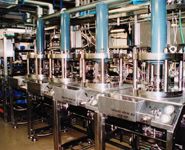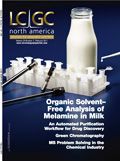Still a Young Technology, Chiral Chromatography Makes Big Strides in Pharma
LCGC North America
Chiral chromatography is now the fastest way to access large amounts of enantiopure pharmaceutical compounds.
I was in my fourth year of pharmacology studies at the University of Barcelona when the syllabus covered medicinal chemistry. This remarkable area sparked an interest in the interaction of molecules with living systems, and it was at this point that I learned the importance of chirality in life science.

At the time, analytical use of chiral chromatography was on the rise, and researchers had just begun investigating chiral chromatography for preparative separations. There were still many questions surrounding the science, but the technological advances were exciting.
While finishing my pharmacy studies, I began working in a laboratory at the University of Barcelona with Cristina Minguillón — one of my former professors — on the preparation of chiral stationary phases (CSPs). After graduating in 1992, I started my doctorate with a focus on the preparation and use of polysaccharide derivatives as chiral stationary phases for high performance liquid chromatography (HPLC) under the supervision of Prof. Minguillón and Laureano Oliveros.
During this time, I studied the preparation, optimization, and subsequent testing of Pirkle CSPs, which were commercially introduced in 1980. These were named for William Pirkle, emeritus professor of chemistry at the University of Illinois. Pirkle CSPs can separate a variety of drug compound groups, including nonsteroidal anti-inflammatory drugs and beta blockers. Pirkle CSPs were only a portion of my thesis, however. I also researched the synthesis of immobilized polysaccharide-derived CSPs, which became the main topic of my doctorate work.
My first chiral separation was with analytical resolutions of enantiomers with the first CSPs I had prepared in the laboratory. At that time, the equipment was not very sophisticated — manual injectors, integrators, and no computer control — but it still helped me understand the mechanisms. Computer control came soon enough, following which research advanced more quickly.
My doctoral work led me to be published in several international journals. My research demonstrated the possibility of producing immobilized CSPs and using them systematically for separating enantiomers. Although the method still was not optimal, it provided good insight into the influence of various parameters that could be considered in producing these new phases, as well as their influence in chiral recognition abilities.

I then completed two years of postdoctoral work with Wolfgang Lindner at the University of Vienna, as a Marie Curie Fellow from the European Commission. During this time, I researched the synthesis of chiral selectors that were mainly derived from cinchona alkaloids. In contrast to the work in Barcelona, which I dedicated mainly to liquid chromatography (HPLC and centrifugal partition chromatography), in Vienna I explored other techniques such as capillary electrophoresis and membrane separations.
Dr. Lindner has deep knowledge of chiral recognition mechanisms and over the years has been developing successful systems for separating enantiomers using various techniques. Some of Dr. Lindner's CSPs have become commercially available, and he has made important findings, but I believe his biggest contribution is all the educational work he has done with chirality throughout his career.
History of Chirality
The study of chiral molecules is actually a branch of stereochemistry, which involves the study of the relative spatial arrangement of atoms within molecules. The term chiral describes an object that can not be superimposed on its mirror image. In chemistry, chirality refers to two molecules.
The mirror images of chiral molecules are called enantiomers (from the Greek enantio, meaning), and enantiomers can exhibit distinct chemical behaviors when subjected to a chiral environment. Chemists often designate these pairs as right- and left-handed. In fact, the term "chirality" is derived from the Greek word for hand (cheir).
Lord Kelvin coined the term chirality in 1873, almost 60 years after the phenomenon was observed by Jean-Baptiste Biot. The property gained considerable importance in the sugar and pharmaceutical industries as well as in the field of analytical chemistry. The term racemic, meaning a mix of both enantiomers, comes from the Latin racemus for "a bunch of grapes." The word originated with Louis Pasteur, who isolated racemic tartaric acid from wine.
One of the most significant examples of chirality is the thalidomide disaster of the 1960s. Although thalidomide originally was used as a tranquilizer, physicians also administered the drug to pregnant women to prevent morning sickness. First developed in Germany in 1957, thalidomide was manufactured and sold as a racemic mixture of N-phthalylglutamic acid imide. The drug's desired physiological activity stems from the (R)-(+)-isomer. Once ingested, thalidomide undergoes racemization inside the human body. So, even if the safe isomer is taken, the other enantiomer is produced. Researchers discovered too late that the corresponding (S)-(–)-enantiomer could cause severe birth defects. It has been estimated that more than 10,000 babies were born with deformations because of this drug.
The thalidomide disaster captured the interest of worldwide drug manufacturers and regulatory agencies. As a result, chiral research took off. The United States Food and Drug Administration later mandated that the isomers of all new drugs be studied individually for their physiological effects. This requirement created a demand for analytical and preparative techniques that were lacking, despite earlier work on CSPs and reagents.
It was not until the 1990s, however, that pharmaceutical manufacturers realized they could use chiral separations to safely analyze pure enantiomers and bring them to market. Significant progress with chiral separations at that time resulted from four essential advances: the introduction of efficient CSPs; the advanced development of simulated moving bed (SMB) chromatography systems; the introduction of computer systems used to model SMB processes; and the integration of efficient evaporation technologies to recycle mobile phases.

In the pharmaceutical industry today, chiral chromatography is clearly established as the fastest and most efficient way to access gram and kilogram quantities of enantiopure substances. Its cost-effectiveness has been demonstrated at large scale with various drugs that have been approved for marketing. Today, it is well known that the drugs Lexapro (escitalopram), Zoloft (sertraline), Keppra (levetiracetam), and Xyzal (levocetirizine) use chiral chromatography in their industrial-scale production processes.
Immobilized CSPs
My research and the studies of others have shown that polysaccharide-derived CSPs are versatile and durable when used for HPLC and supercritical fluid chromatography (SFC) separations. These qualities have made them the first choice for analytical and preparative separations of enantiomers.
CSPs were first introduced to the market as coated materials on a silica support. A great deal of their development was carried out by Yoshio Okamoto at Nagoya University. Okamoto found that he could achieve most enantiomeric separations using four different derivatives. Two are based on cellulose, and two are based on amylose. These polysaccharide phases were developed by deriving amylose or cellulose and coating these chiral polymers on a silica gel base. Among the various polysaccharides available, amylose and cellulose derivatives are the most useful as CSPs. Columns containing these CSPs are equally effective with normal-phase and reversed-phase solvents.
In that format, however, the potential of CSPs was limited by restrictions in the solvent choice, which was dictated by polymer solubility. At that point, immobilized CSPs were created, and the first commercially available immobilized CSP was introduced in 2004.
Many research groups investigated the best way to prepare immobilized CSPs. Researchers with Daicel and Chiral Technologies Worldwide, as well as E. Francotte at Novartis, were at the forefront of immobilization technology. Work by our colleagues at Daicel was essential to the development and Tong Zhang of Chiral Technologies Europe was deeply involved in studying immobilization technologies.
Several methods have been developed to chemically bond, or immobilize, the polysaccharide-based polymer to the silica support, but only a few technologies have worked for a wide range of applications with high efficiencies and an unlimited choice of solvents, including ethyl acetate, dichoromethane, tetrahydrofuran, and acetone.
Nevertheless, immobilizing a chiral polymer on a silica support offers several benefits. First, immobilized CSPs are not damaged when they come into contact with a solvent that swells or dissolves the polymer. Another benefit is that immobilized CSPs allow difficult separations to be performed with solvents that could not be used previously with CSPs. Additionally, new selectivity can be developed by using previously unusable chiral selectors.
Most importantly, perhaps, immobilizing chiral polymers brings a new generation of polysaccharide-based CSPs in line with existing HPLC phases. Immobilized CSPs help extend column life and eliminate unexpected column failures.
Preparative Chromatography
Since the 1990s, chiral chromatography has been growing by leaps and bounds. The technology itself has improved vastly, especially in the area of preparative chiral chromatography. Now, chiral chromatography systems are becoming mandatory tools in chemical processing and research and development departments, particularly in the area of preparative separations.
In the past, pharmaceutical manufacturers viewed preparative chromatography as a time-consuming and expensive process. Today, it has evolved to allow manufacturers to perform fast and cost-effective separations using automated equipment for techniques such as continuous chromatography and SFC. In fact, pharmaceutical companies have developed chiral chromatography methods — from feasibility study to production — in less than one year.
Continuous chromatography, also referred to as SMB, has been around since the 1950s, but initially it was only applicable to manufacturing foods and sugars. It wasn't until it became possible to operate SMB systems at high pressures that pharmaceutical companies could start harnessing it for drug development.
SMB is now a workhorse in Big Pharma companies like GlaxoSmithKline, Merck, and Pfizer. The largest SMB units process up to 200 metric tons of material annually. This is extraordinary, given that when I started in preparative solutions, we could only create 1 g at a time.
Companies using SMB can now expect to complete method development in a few months as opposed to two to five years for asymmetric methods that also have a much higher cost. It has been projected that chiral chromatographies will continue to evolve in tandem with the growth of single-enantiomer, small-molecule drugs.
A related technology that has been advancing is SFC. Although SFC systems were invented before the 1990s, initially the technology was not very well established. Today, SFC systems are more robust and it is becoming a well established technique. SFC is important for enantioselective separations, especially for preparative purification and isolation of individual enantiomers.
SFC offers significant benefits, including faster separation and method development and improved column efficiency. But in larger separations, the benefits of SFC go beyond speed. Its use of carbon dioxide makes SFC a "green" technology because it doesn't add anything to the atmosphere, and the consumption of organic solvents is greatly reduced. Also, chemists can recover separated products more quickly because isolated fractions are collected in smaller volumes of liquid.
Moving forward, the continued development of advanced CSPs and improved commercial-scale processes will ensure that preparative chiral chromatography is viewed as an equal to other technologies in the pharmaceutical industry. Pharmaceutical researchers are embracing new chiral technologies, and methods such as SFC are becoming more and more accepted.
Pilar Franco, PhD, is the manager of technical operations for Chiral Technologies Europe. Direct correspondence about this column to pfranco@chiral.fr or tel. +33.388795200.

HILIC Peptide Retention Times Predicted Using New Approach
October 29th 2024Manitoba Centre for Proteomics and Systems Biology scientists produced a new means of predicting peptide retention times for hydrophilic interaction liquid chromatography (HILIC) at acidic pH in formic-acid based eluents.